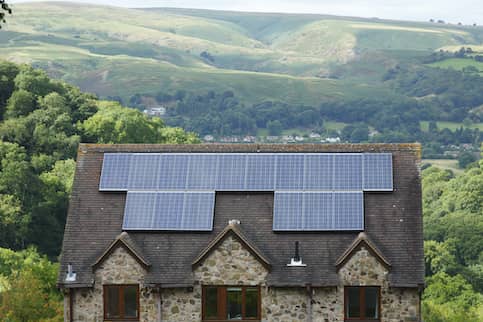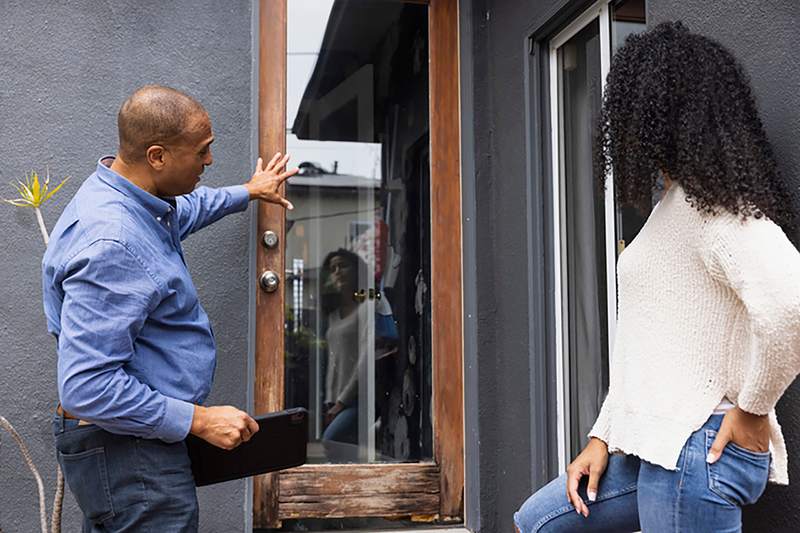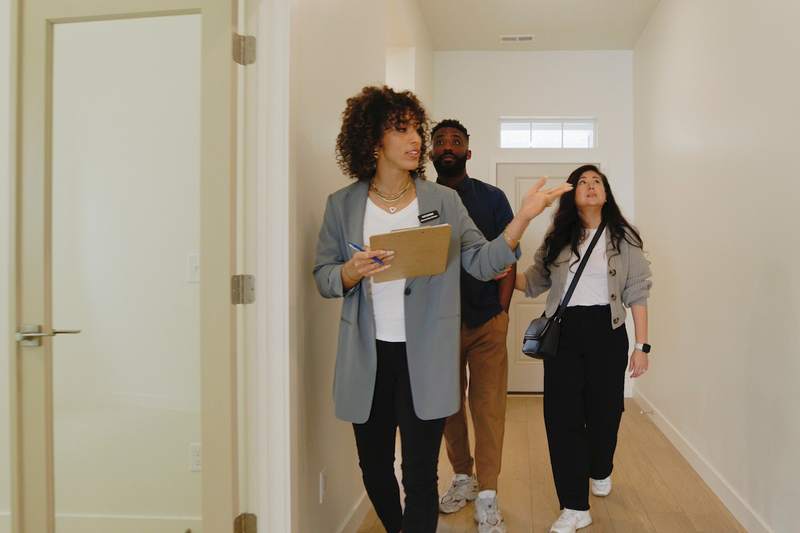To buy a home, you generally need a decent credit score and a down payment to qualify for a mortgage. But what if your credit score needs work and you don’t have enough money to make a down payment on a home?
If you’re trying to decide between renting or buying a home, one option to consider is a rent-to-own home. But it’s important to understand how the process works, as well as the advantages and potential risks.
Key Takeaways:
- A rent-to-own agreement lets you rent a property with the option or obligation to buy it when the lease ends.
- Rent payments may partially contribute to the purchase price, and some agreements require you to maintain the property and cover repairs.
- There can be benefits to buying a rent-to-own property, but there are risks you should know about, too.
What Is A Rent-To-Own Home?
With a rent-to-own home – also called a lease-to-own home – you sign a lease agreement that usually lasts 1 – 5 years. A portion of your monthly rent typically goes toward the home’s purchase price. Once you get to the end of your lease, you’ll either have the option to purchase the home or be required to purchase it, depending on the terms of your contract.
Who Are Rent-To-Own Houses Right For?
Rent-to-own homes are ideal for aspiring homeowners who need time to improve their finances, build credit or save for a down payment. Rent-to-own agreements often allow renters to build equity through rent credits applied toward the purchase price. While traditionally designed for those who can’t qualify for conforming loans, they are also becoming a solution for creditworthy buyers in high-cost markets where jumbo loans are the norm.
How Does Rent-To-Own Work?
Rent-to-own agreements start when a buyer and a homeowner formally agree that the buyer can rent the property for a given period. Depending on the agreement, the buyer is either required to purchase the property at the end of the lease term or is given the option to buy the property.
Buyers who enter into rent-to-own agreements pay a one-time premium – sometimes called an option fee – on top of rent. The premium contributes to the down payment and is usually nonrefundable. The fee adds a financial incentive for renters who feel confident about buying the property at the end of the lease agreement, and it protects sellers.
Types Of Rent-To-Own Contracts: Lease Option Vs. Lease Purchase
Rent-to-own contracts usually include one of two provisions: a lease option and a lease purchase. With a lease option, you’re not legally obligated to buy the home at the end of your lease. With a lease purchase, you have a legal obligation to buy the home once your lease term is up.
As a potential buyer, you get less protection with a lease purchase option. Make sure the home meets your long-term needs and review your contract carefully with a real estate attorney before signing it. Also speak to a mortgage lender to confirm that you can meet the loan requirements when it’s time to buy the home.
What’s Your Goal?
Buy A Home
Discover mortgage options that fit your unique financial needs.

Refinance
Refinance your mortgage to have more money for what matters.
Tap Into Equity
Use your home’s equity and unlock cash to achieve your goals.
Rent-To-Own Pros And Cons For Home Buyers
Rent-to-own agreements aren’t right for everyone. Like all financial decisions, it’s important to consider both the benefits and drawbacks.
Rent-To-Own Pros And Cons For Home Buyers
| Pros | Cons |
|---|---|
| Path to homeownership: Rent-to-own agreements allow aspiring homeowners to work toward buying a home even if they aren’t financially ready yet. | Higher costs: Rent is typically more expensive than with a traditional rental since a portion goes toward a home purchase. Plus, your upfront premium is nonrefundable if the deal falls through. |
| Financial flexibility: Buyers have time to improve their credit score, save for a down payment and stabilize their finances while securing the home they want. | Financial risk: You could lose money if the property value drops or if you decide not to purchase the home after the lease ends. And if you’re denied a mortgage and can’t move forward with a purchase, you’ll typically have to forfeit your option premium that was supposed to go toward the home’s purchase price, plus the portion of your rent payments that was earmarked for that purpose. |
| Equity building: Option money and a portion of rent payments often go toward the purchase price, allowing buyers to build home equity during the rental period. | Uncertainty in value: At the end of the agreement, the purchase price you agreed to may be higher than what the home is worth. |
| Price protection: Rent-to-own contracts often lock in the purchase price, protecting buyers from rising home prices in competitive markets. | Repair and maintenance expenses: Although the property isn’t yours, you may be responsible for costly repairs and upkeep. |
| Accessibility in high-cost markets: Rent-to-own agreements offer an alternative for buyers who cannot meet strict underwriting guidelines or make large down payments for jumbo loans or other large loans needed in expensive markets. | Seller-favored terms: Rent-to-own contracts often benefit sellers, who can terminate the agreement over minor issues, leaving you with no recourse. |
| Flexibility for nontraditional buyers: Rent-to-own arrangements are ideal for self-employed people, contract workers, foreign nationals without a U.S. credit history or those with nontraditional incomes. | Potential loss of equity: If the seller faces foreclosure or breaches the contract, you risk losing any equity or payments made toward the home. |
Ready To Become A Homeowner?
Get matched with a lender that can help you find the right mortgage.
How To Purchase A Rent-To-Own Home In 7 Steps
There’s more to rent-to-own than paying rent until you purchase the home. Here’s how it works.
1. Find A Rent-To-Own Home
A good place to start is rental listings. Filter the listings to display rent-to-own housing. If you’re already renting a home, see if a lease-to-own agreement is something your landlord is open to. You can also work with a real estate agent to find a rent-to-own home.
2. Negotiate A Rent-To-Own Agreement
Aim to negotiate a fair purchase price, either up front or at the lease’s expiration, based on market value. When signing the contract, carefully review the lease option or lease purchase agreement, ensuring it includes clear terms on renter responsibilities, purchase price, rent credits and maintenance requirements.
3. Get A Home Inspection And Appraisal
Any time you’re looking to buy a home, it’s crucial to get a home inspection and appraisal. The purpose of a home appraisal is to establish the home’s fair market value and verify that the agreed purchase price is fair.
When you sign a rent-to-own contract, the purchase price you agree to up front is generally set. You’ll pay that price even if the home is worth less by the end of your lease. Since a lender can’t lend more than the appraised value, you may have to find a way to pay the difference. You should also schedule a home inspection before you sign the agreement to help make sure you aren’t agreeing to purchase a home needing significant repairs.
4. Do Your Due Diligence
To protect yourself from rent-to-own scams, ensure that the home’s property taxes are up to date and there are no liens on the property. You’ll also need to check that the landlord is the rightful property owner. Review recent tax bills, conduct a house title search or look at recent mortgage statements for verification.
Before you sign the agreement and pay rent and the option fee, have a real estate attorney review the agreement and explain your rights. Find out what happens if you miss a payment or make a late payment.
5. Pay The Option Fee
After signing the contract, you’ll pay the one-time, nonrefundable option fee, also known as the option premium. It gives you the first opportunity to purchase the home at the end of your lease and prevents anyone else from purchasing the home while you’re leasing it.
The fee amount can vary but is usually 1% – 5% of the home’s final sale price and contributes to the down payment. With some lease purchase agreements, you may not need to pay an option fee.
6. Make On-Time Monthly Payments
You must make your monthly payments on time. Remember that a portion of your monthly payments may be applied toward the home’s purchase price. A late or missing payment may void your agreement, and you’ll risk losing the money you invested in the home. Paying on time can also help you build credit, which could help you secure a mortgage at the end of your lease.
7. Secure A Mortgage
As you get closer to the end of your lease, shop for a mortgage or other financing to buy the property if you choose (or are obligated) to purchase it. Lenders may quote different interest rates and closing costs. Read your loan terms carefully and use online tools, like a mortgage calculator, to see how much your monthly mortgage payments might be. Aim to choose a mortgage lender that offers favorable terms coupled with great customer service.
Take The First Step To Buying A Home
Find a lender that will work with your unique financial situation.
FAQ
Here are some common questions about the rent-to-own process.
If you’re being offered a home below market value, it may be a red flag that something is amiss. Work with a real estate agent to find a rent-to-own home if it’s an option you’re interested in.
Another common scam is to sell a home with hidden issues. Get a thorough home inspection before signing a contract so you’re not stuck with costly repairs.
The Bottom Line: Before You Sign
Rent-to-own homes are a good path to homeownership for some people, but there are pitfalls to know about. If you’re interested in a rent-to-own home, research your options carefully and review your rent-to-own agreement so you understand your financial obligation at the end of the lease period. Pay attention to payment terms and your obligations as a tenant, and have an attorney review your contract to ensure that it’s fair.
Also make sure to do the same due diligence you would for a traditional home purchase. Obtain an appraisal, have an inspection done and make sure the seller is current on their property tax bill. The more research you do, the more likely you are to enjoy a successful rent-to-own arrangement that leads to you achieving your dream of homeownership.

Maurie Backman
Maurie Backman has more than a decade of experience covering personal finance topics that include mortgages, loans, retirement, Social Security, and investing. Prior to becoming a full-time writer, she worked in the financial industry as well as in product design and marketing. Maurie holds a bachelor's degree from Binghamton University, where she studied creative writing and finance. She was happy to combine her two areas of study into a career that allows her to educate consumers on a host of financial topics.












